#plastic waste crisis
Explore tagged Tumblr posts
Text

#petrochemical industry#plastic waste#recycling#environmental impact#public health crisis#fossil fuel companies#deception#corporate responsibility#environmental justice#pollution#plastic pollution#recycling limitations#economic factors#health risks#plastic recycling#public relations#lobbying efforts#recycling promotion#industry front groups#corporate strategies#circular economy#recycling research#environmental education#corporate awareness#sustainability claims
13 notes
·
View notes
Video
youtube
#youtube#environment#climate#climate change#climate crisis#climate catastrophe#climate collapse#enviromentalism#environmetalists#plastic#waste#biodiversity crisis#capitalism#anti capitalism#neoliberal capitalism#late stage capitalism#anti capitalist#capitalist hell#capitalist dystopia#class war#eat the rich#kill the rich#eat the 1%
5 notes
·
View notes
Text
Riciclare la plastica?

Riciclare la plastica non basta. Occorre soprattutto limitare la sua produzione nei prossimi anni, ad esempio eliminando del tutto la plastica monouso.
Il consumo e quindi la produzione globale di plastica sono raddoppiati in vent'anni, siamo a 430 milioni di tonnellate nel 2021, con la prospettiva di un ulteriore raddoppio da qui al 2040, in base ai dati dell’Onu. Questa valanga di materia indistruttibile inquina gli ecosistemi marini e terrestri in maniera sempre più capillare, entrando nella catena alimentare e arrivando sulle nostre tavole.
L'Italia è la seconda consumatrice di plastica a livello europeo dopo la Germania: nel 2020 abbiamo consumato quasi sei milioni di tonnellate di plastica, pari a 98 chili per persona.
#sostenibilità#decrescita#ambiente#cambiamenti climatici#crisi climatica#plastic waste#plastica#riciclo#plastica monouso#monouso#onu#italia#consumo#ecosistemi#catena alimentare
3 notes
·
View notes
Text
World’s first ice cream made from plastic
Reuters | 28 September 2023

The world’s first food made from plastic waste - according to its developer - is vanilla ice cream.
Despite being locked in a freezer in London, she hopes it kickstarts a heated debate about the future of food and the plastic pollution crisis.
The ice cream is actually an art installation called ‘Guilty Flavours’ by artist and designer Eleanora Ortolani, 27, intended to challenge the way we think about plastic waste and what we are - and are not - prepared to eat.
"Guilty Flavours is what I believe is the first sample of ice cream made from plastic waste,” Ortolani told Reuters at Central Saint Martins, part of the University of the Arts London.
“It's coming from the same plastic as we can find in bottles, plastic bottles,” she said.
The process, developed by scientists in Edinburgh, harnesses the metabolic power of bacteria and enzymes to behave as eco-friendly factories to digest polyethylene terephthalate (PET) and turn it into vanillin, the molecule that gives vanilla its flavour.
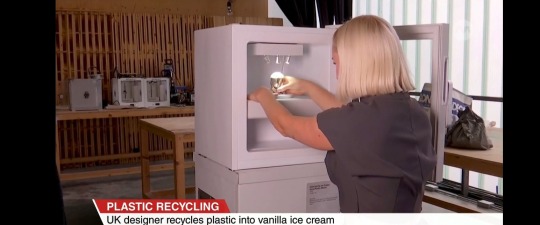
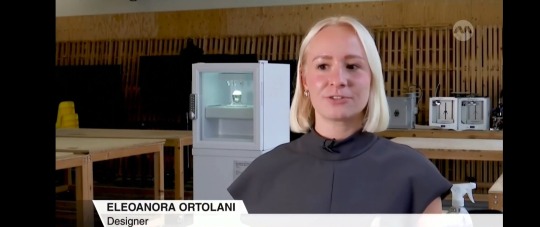
“There are certain enzymes which do certain chemical reaction,” Dr Joanna Sadler, a biotechnologist at the University of Edinburgh, told Reuters.
“So if you plug those together, you can get through to lots of different chemical products," she said.
Plastic is made of a string of molecules bonded together into what are known as polymers.
Sadler broke those bonds with a hungry microbe, leaving her with molecules that were no longer plastic.
That former PET-soup was then easily processed by another bacteria into vanillin.
Sadler's research, published in the Journal Biochemist in December 2021, focuses on degrading and upcycling plastic and using it as feedstock for microbial growth.
She produced the specially engineered bugs for Ortolani's project but was at pains to point out that the student's ice cream is very much a research project.
It's not currently for human consumption.
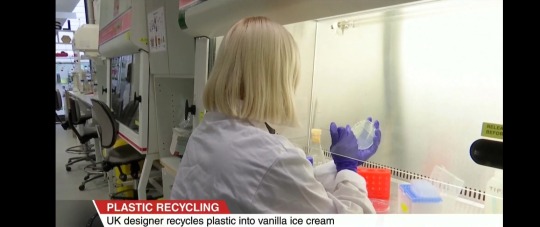
"I've even had members of the public email me saying it's irresponsible to encourage people to eat plastic," Sadler said.
"It is really important that we take the safety side of it really, really seriously and we make it very clear that this has to go through exactly the same regulatory processes and food standard processes as any other food ingredient.
And only once it has been through all of those would it go anywhere near any kind of consumer product."
Ortolani, who is from Verona, Italy, said Guilty Flavours was inspired by her frustration with the failure of the recycling system to stop plastic polluting the environment.
It is locked away to highlight what she says is a looming global food crisis.
“We have the tools today to rethink the food system we're living in,” she said.
“This is ready now and today but nobody can really touch it or interact with it because it's not tested for safety yet."
Vanilla, sometimes called 'green gold', is the second most expensive spice in the world after saffron.
youtube
UK designer recycles plastic into vanilla ice cream
27 September 2023
Introducing the world's first food made from plastic waste... vanilla ice cream!
Named Guilty Flavours, the ice cream has been designed to provoke viewers into thinking about plastic waste.
The ice cream was developed by scientists in Edinburgh, who used bacteria and enzymes to digest PET plastic and turn it into vanillin -- the molecule that gives vanilla its flavour.
The ice cream is still in its research phase and currently not for human consumption.
#Guilty Flavours#vanillin#vanilla ice cream#ice cream#plastic waste#PET plastic#plastic pollution crisis#Youtube#Eleanora Ortolani#Central Saint Martins#University of the Arts London#polyethylene terephthalate (PET)#Dr Joanna Sadler#University of Edinburgh#plastic#polymers#Journal Biochemist#vanilla#green gold#biotechnology#recycle#upcycle
4 notes
·
View notes
Text
The cosmetics mega-brand Dove campaigns about how much they ”care about women and girls” while at the same time polluting this planet with massive amounts of single-use plastic. Click the link below and sign a letter to tell Dove it’s time to actually start caring for the wellbeing of their customers!
#sign the petition#please sign and share#petition#environment and nature#sign and share#climate change#environmental crisis#climate action#environment#pollution#polluted water#no plastic#plastic waste#plastic#nature#cosmetics#makeup#hypocrite#greenpeace#climate activism#take action#activist#capitalism#trash#garbage#recycle#recycling#animal rights#cosmetology#help
3 notes
·
View notes
Text
Global Negotiations Begin for Plastic Pollution Treaty in Busan
Global Negotiations on Plastic Pollution Treaty Begin in Busan Following the contentious climate discussions held in Azerbaijan, representatives from various nations are gathering in Busan, South Korea, this week with an ambitious goal: to finalize the world’s first treaty aimed at addressing the alarming surge in plastic pollution. The proposed agreement seeks to significantly reduce the…
#Busan#climate change#environmental crisis#global agreement#marine life#plastic pollution#plastic waste reduction#single-use plastics#treaty negotiations#United Nations
0 notes
Text

Washington Channel, DC Nov 2024 © julieb-b
0 notes
Text

500 milhões de toneladas de plástico são produzidas anualmente, mas apenas nove por cento são recicladas globalmente. Os plásticos estão em todo lugar: do topo do Monte Everest até a parte mais profunda da Fossa das Marianas.🌎
#biology#biologia#ecologia#ecology#plastic#plastic waste#garbage#trash#plastic pollution#poluicao plastica#plasticos#plastico#lixo#crise global#crisis#poluicao
1 note
·
View note
Text
Could Plastic Made From Bacteria Guts Help Solve Our Waste Crisis?
Bioplastics called PHAs grow like beer and biodegrade like wood. And they may be able to help with our plastic waste problem.
— By Alissa Greenberg | Published: Wednesday March 17, 2021
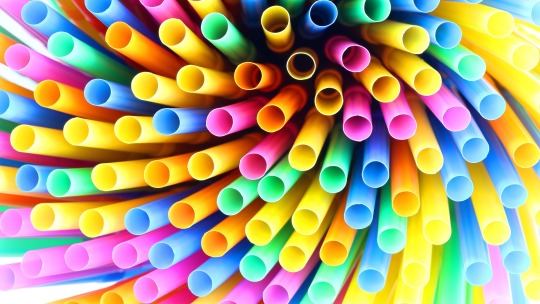
Drinking straws are one of many single-use plastic products that could potentially be produced using biopolymers. Image Credit: Phichai, Shutterstock
Despite the efforts of recycling programs and environmental education, it’s still hard for many of us to grasp just how much plastic humans produce. We are on track to produce a billion tons of plastic a year by 2050. Cumulatively, we’ve already produced more than 8.3 billion metric tons since 1950. That’s 20 times the weight of all human beings alive right now.
The systems we’ve developed for recycling that plastic are full of logistical, political, and economic obstacles, and the numbers show it. By 2015, three quarters of those 8 billion metric tons of plastic were already out of use, with 9% of it having been recycled and 12% incinerated. A whopping 79% wound up in landfills or the natural environment, destined to sit virtually unchanged for hundreds, if not thousands, of years.
It doesn’t have to be this way. “Plastic” is a category that encompasses a huge diversity of materials with one thing in common: They’re made of repeating chains of molecules known as “polymers” and can be molded or extruded while soft to take particular shapes. Until recently, we've only looked to petrochemicals (made from crude oil and natural gas) to create plastics with the properties we find so useful: the rigidity of takeout utensils, the flexibility of plastic films, the moisture barrier that contains greasy food. Although some less-common petroplastics are indeed biodegradable, bioplastics—which are often made from plant materials like sugar cane pulp, corn, or cassava and in many cases biodegrade after relatively short periods—may also be able to help address our big plastic problem.
Enter polyhydroxyalkanoates, also known as PHAs, polymers used to make biodegradable bioplastics from an unlikely source: bacteria guts. PHAs and other bioplastics seek to challenge our assumptions about what plastic can be, and companies like Danimer in Georgia and Mango Materials in California are betting big that their products can help make a dent in our plastic waste numbers. Danimer’s partnership with Bacardi will see that company unveiling PHA bottles in all of its liquor lines by 2023; it also has partnerships in the works with Nestle, Pepsico, and other giants of single-use plastic. Meanwhile, Mango is making inroads into other plastic-reliant industries, like apparel. (Yes, your workout clothes have plastic in them.)
But PHAs aren’t new. They’ve been around for 35 years, and doubters like to point to Metabolix, a PHA company that seemed promising, grew quickly, and then collapsed in 2016. Metabolix and other would-be innovators have lived and died trying to “make PHAs happen.” Is now the time for this bioplastic to break through?
You might not think plastic and beer have much in common, but in the case of PHAs, there’s some surprising overlap. The bio-based plastic is derived from what amounts to bacteria guts, a polymer the microorganisms use to turn food into energy stored away for a rainy day. To make that polymer into something usable for humans, PHA scientists and entrepreneurs grow the bacteria in big vats under specific conditions, feeding them with vegetable oil, sugar, or methane gas and waiting to harvest the results. So far, kinda like beer.
Here’s where it gets a little different. When the bacteria have gotten so full and roly-poly that they’re barely bacteria anymore—when their cells have gone from around 3% polymer to upwards of 95%—they’re subject to a purification process that bursts their membranes and brings the polymer out of solution. The resulting white powder is combined in pellets that then can be made into straws and takeout containers. Voila: plastic that’s not just made without fossil fuels but is also fully compostable, biodegrading in both your backyard and the ocean.
We’ve known about bacteria’s capacity to manufacture plastic since the 1920s. But it took until 1983 to figure out how to get the polymers from inside the bacteria into human hands and until quite recently for that to happen on a scale that could be commercialized. “If you think of what we knew in the early 20th century about bacteria, microscopy, evolution, all those things have rapidly evolved,” says Mango Materials CEO Molly Morse. Only in the last decade have we had the tool set to make PHAs a reality.
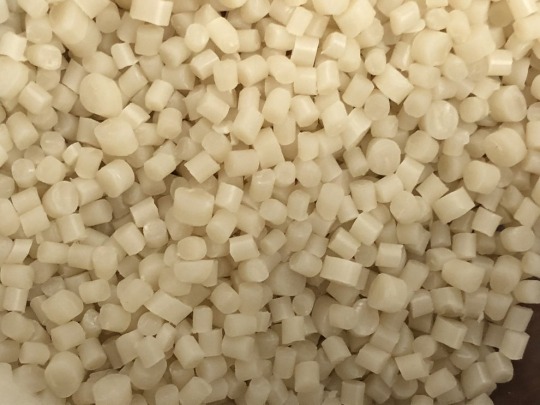
Pellets made from PHA biopolymers. Photo courtesy of Mango Materials
Now, there are over 150 types of PHAs, which differ based on the length of their molecules, how they’re structured, which microorganisms are producing them, and what those microorganisms are fed. The longer the molecule chains, the more flexible and stretchable the plastic is; the shorter they are, the more brittle the material becomes. PHAs melt and flow like petroplastics and they can be turned into sheets or molded into many forms. That makes them great for all kinds of applications with one thing in common: whether in backyard compost, in industrial composting facilities, or in the ocean, they’ll completely biodegrade within six months.
The big difference is that petroplastics are synthetic, and while bacteria may attempt to break them down, those organisms lack enzymes to break the plastics’ carbon-carbon bonds, making full degradation impossible. But since bacteria already use PHAs to store energy, they have built-in ways to both recognize and break them down. That’s what makes PHAs uniquely biodegradable—but only in specific settings. To understand why this is possible, “think about wood,” says Danimer Chief Technology Officer Phil Van Trump. If you build your desk out of wood, it won’t just disappear out of your house one day; it needs the right environment for that. “But in your yard, it’s a different story. Put it back in that environment, and bacteria and fungi will recognize it as food and start in on it.”
Of course, there are some drawbacks. In plastic-nerd parlance, PHAs have a “narrow processing window,” which means that their melting point and the point at which heat transforms them chemically into something else are only 10 degrees apart. That limits the ways they can be processed to stand in for petroplastics—for example, in materials that are subjected to very high heat or need very high mechanical strength, like airplane windshields, car bumpers, or bulletproof vests. But PHAs' biggest drawback is cost. Production is relatively expensive, especially the part of the process that draws the polymer out of the bacteria, says Amar Mohanty, a polymer and plastics engineer at the University of Guelph in Canada. Though there are different techniques for doing so, they often require large amounts of expensive chemicals like acetone or chloroform. “And to get a really purified polymer, you need to repeat the steps two or three times,” adds his colleague, fellow engineer Manjusri Misra.
PHAs, like other bioplastics, also release methane when they degrade under anaerobic conditions (like in landfills). Since methane is a major contributor to greenhouse gas emissions, some critics worry that if PHA products grow popular and then are improperly disposed of, they may end up contributing to the climate crisis. In response, Van Trump and Mohanty stress the importance of developing proper waste-disposal infrastructure along with PHA technology, including industrial composting and digesters. “There’s growing we need to do as a society with how much we stick in landfills,” Van Trump says.
In her work at Mango Materials, Morse has taken the methane release issue in a different direction, since Mango’s PHA bacteria actually feed on methane to grow their polymer. Mango has even partnered with Silicon Valley Clean Water in Redwood City, California, to build a digester on site and harness the methane coming off the city’s waste. At just that single location, Mango could produce up to 10 million pounds of PHA plastic per year.
And then there’s the question of toxicity. In a recent study, Lisa Zimmerman, a biologist at Goethe University in Germany, tested 40 different bioplastics, including one PHA product, and found they were not on average any less toxic than regular plastics. And when chemicals from the bioplastics leached into an environment where Zimmerman was raising microorganisms, many of them (including those from the PHA product) exhibited the potential to simulate hormones and interrupt the organisms’ metabolisms. Since some of the products she tested were not toxic, Zimmerman sees her result as an impetus to increase industry transparency. “The problem is that the product composition is not made openly available, so it’s really hard for other producers to integrate those less harmful chemicals,” she says. “To scale up, it would really help if it was openly communicated what is in the product.”

Plastic caps (left) and film (right) produced from PHA biopolymers. Photos courtesy of Mango Materials
Still, all the people interviewed for this article see the current moment as a time with enormous potential for bioplastics. As recently as 2014, when Mango applied for funding through the National Science Foundation to work on marine plastic pollution, their application was denied because the foundation “didn’t believe plastics in the ocean were a problem,” Morse says. She’s seen huge societal change since then, even noticing a difference just within the period of the COVID-19 pandemic. “People are at home staring at their trash cans wondering where all this stuff is going,” she says. “We’ve seen interest in the past 12 months like never before.”
Van Trump also sees a major change in the attitudes of the corporations Danimer is partnering with, like Pepsi, Nestle, and Bacardi, which now seem more willing to invest in solutions to the plastics problem. “We’re growing like a weed,” he says of Danimer, which just opened new facilities in Georgia and Kentucky. And Van Trump and Morse both point out that price and scale are intimately connected. Bioplastics like PHAs are competing against a petroplastics industry producing in simply enormous volumes, with some single plants producing a billion pounds a year—and economies of scale make it possible for petroplastics companies to keep their prices low. “The industry has had 70 to 80 years to optimize and build capacity,” Van Trump says. He holds out hope, though, that “when we get to the scales of the ‘traditional’ polymers, then costs will come down dramatically.”
In fact, Mohanty says the current problem for PHAs is the opposite of what it was in the days of Metabolix: too much demand and not enough production capacity. He expects the industry will grow into that demand in the coming decade, especially as widespread single-use petroplastic bans go into effect. The key, in the meantime, is to educate consumers about their options and to build enough infrastructure that all those new PHA containers and films and straws don’t end up in landfills. Of our voracious plastic appetite, he says, “If we cannot stay away from it, we have to find ways to handle it.”
0 notes
Text
Masterpost: Reasons I firmly believe we will beat climate change
Posts are in reverse chronological order (by post date, not article date), mostly taken from my "climate change" tag, which I went through all the way back to the literal beginning of my blog. Will update periodically.
Especially big deal articles/posts are in bold.
Big picture:
Mature trees offer hope in world of rising emissions (x)
Spying from space: How satellites can help identify and rein in a potent climate pollutant (x)
Good news: Tiny urban green spaces can cool cities and save lives (x)
Conservation and economic development go hand in hand, more often than expected (x)
The exponential growth of solar power will change the world (x)
Sun Machines: Solar, an energy that gets cheaper and cheaper, is going to be huge (x)
Wealthy nations finally deliver promised climate aid, as calls for more equitable funding for poor countries grow (x)
For Earth Day 2024, experts are spreading optimism – not doom. Here's why. (x)
Opinion: I’m a Climate Scientist. I’m Not Screaming Into the Void Anymore. (x)
The World’s Forests Are Doing Much Better Than We Think (x)
‘Staggering’ green growth gives hope for 1.5C, says global energy chief (x)
Beyond Catastrophe: A New Climate Reality Is Coming Into View (x)
Young Forests Capture Carbon Quicker than Previously Thought (x)
Yes, climate change can be beaten by 2050. Here's how. (x)
Soil improvements could keep planet within 1.5C heating target, research shows (x)
The global treaty to save the ozone layer has also slowed Arctic ice melt (x)
The doomers are wrong about humanity’s future — and its past (x)
Scientists Find Methane is Actually Offsetting 30% of its Own Heating Effect on Planet (x)
Are debt-for-climate swaps finally taking off? (x)
High seas treaty: historic deal to protect international waters finally reached at UN (x)
How Could Positive ‘Tipping Points’ Accelerate Climate Action? (x)
Specific examples:
Environmental Campaigners Celebrate As Labour Ends Tory Ban On New Onshore Wind Projects (x)
Private firms are driving a revolution in solar power in Africa (x)
How the small Pacific island nation of Vanuatu drastically cut plastic pollution (x)
Rewilding sites have seen 400% increase in jobs since 2008, research finds [Scotland] (x)
The American Climate Corps take flight, with most jobs based in the West (x)
Waste Heat Generated from Electronics to Warm Finnish City in Winter Thanks to Groundbreaking Thermal Energy Project (x)
Climate protection is now a human right — and lawsuits will follow [European Union] (x)
A new EU ecocide law ‘marks the end of impunity for environmental criminals’ (x)
Solar hits a renewable energy milestone not seen since WWII [United States] (x)
These are the climate grannies. They’ll do whatever it takes to protect their grandchildren. [United States and Native American Nations] (x)
Century of Tree Planting Stalls the Warming Effects in the Eastern United States, Says Study (x)
Chart: Wind and solar are closing in on fossil fuels in the EU (x)
UK use of gas and coal for electricity at lowest since 1957, figures show (x)
Countries That Generate 100% Renewable Energy Electricity (x)
Indigenous advocacy leads to largest dam removal project in US history [United States and Native American Nations] (x)
India’s clean energy transition is rapidly underway, benefiting the entire world (x)
China is set to shatter its wind and solar target five years early, new report finds (x)
‘Game changing’: spate of US lawsuits calls big oil to account for climate crisis (x)
Largest-ever data set collection shows how coral reefs can survive climate change (x)
The Biggest Climate Bill of Your Life - But What Does It DO? [United States] (x)
Good Climate News: Headline Roundup April 1st through April 15th, 2023 (x)
How agroforestry can restore degraded lands and provide income in the Amazon (x) [Brazil]
Loss of Climate-Crucial Mangrove Forests Has Slowed to Near-Negligable Amount Worldwide, Report Hails (x)
Agroecology schools help communities restore degraded land in Guatemala (x)
Climate adaptation:
Solar-powered generators pull clean drinking water 'from thin air,' aiding communities in need: 'It transforms lives' (x)
‘Sponge’ Cities Combat Urban Flooding by Letting Nature Do the Work [China] (x)
Indian Engineers Tackle Water Shortages with Star Wars Tech in Kerala (x)
A green roof or rooftop solar? You can combine them in a biosolar roof — boosting both biodiversity and power output (x)
Global death tolls from natural disasters have actually plummeted over the last century (x)
Los Angeles Just Proved How Spongy a City Can Be (x)
This city turns sewage into drinking water in 24 hours. The concept is catching on [Namibia] (x)
Plants teach their offspring how to adapt to climate change, scientists find (x)
Resurrecting Climate-Resilient Rice in India (x)
Other Masterposts:
Going carbon negative and how we're going to fix global heating (x)
#climate change#climate crisis#climate action#climate emergency#climate anxiety#climate solutions#fossil fuels#pollution#carbon emissions#solar power#wind power#trees#forests#tree planting#biodiversity#natural disasters#renewables#renewable electricity#united states#china#india#indigenous nations#european union#plant biology#brazil#uk#vanuatu#scotland#england#methane
2K notes
·
View notes
Text
Overcoming the Plastic Waste Crisis - A Multifaceted Approach Needed to Drive Change

The plastic waste crisis has escalated to a critical level, with an overwhelming amount of waste accumulating in our oceans, landfills, and ecosystems. The consequences of our dependence on plastics are becoming increasingly evident, impacting not only the environment but also public health, biodiversity, climate change, and human rights. Despite the urgency of the situation, many companies have been slow to take action. Consequently, a coalition of investors, managing $10tn in assets, is urging major companies like The Coca-Cola Company, Unilever, Amazon, PepsiCo, and McDonald's to take "urgent action" and significantly reduce their plastic footprint.
While investor pressure is undeniably essential in combatting plastic waste, it represents only one aspect of a comprehensive, long-term solution. To encourage companies to take more action on tackling plastic waste, we must first identify the underlying factors contributing to this crisis and implement multifaceted strategies that focus on several key areas where change can make a significant impact.
Firstly, governments should establish a robust regulatory framework by implementing stricter regulations and guidelines to limit plastic production and consumption. Enforcing these rules will compel companies to seek sustainable alternatives and reduce their reliance on single-use plastics. Furthermore, governments should incentivise research and development of eco-friendly materials and packaging solutions.
Secondly, investors and financial institutions should continue using their influence to encourage companies to adopt sustainable business models. By withholding investments or offering financial incentives, such as lower interest rates for companies with strong environmental, social, and governance (ESG) performance, they can guide businesses towards reducing their plastic footprint.
Thirdly, the power of consumer choice is a force that should not be underestimated. Raising awareness of the plastic waste crisis and encouraging consumers to vote with their wallets will make companies more inclined to adopt environmentally friendly practices. Social media campaigns, educational initiatives, and grassroots movements can play a crucial role in shifting public opinion and consumer behaviour.
Fourthly, companies should be encouraged to adopt a circular economy model, which emphasises reducing material consumption, reusing and recycling resources, and minimising waste. By doing so, they can lessen their environmental impact and create a more sustainable future.
Lastly, transparency and accountability are paramount. Companies must be open about their plastic usage and waste management strategies, enabling consumers and investors to hold them accountable for their actions. This can be achieved through regular reporting, third-party audits, and public commitments to reduce plastic waste.
In conclusion, the responsibility to address the plastic waste crisis lies with all stakeholders, including governments, investors, companies, and consumers. By working together and adopting a multifaceted approach, we can encourage companies to make significant strides in reducing their plastic footprint, paving the way for a more sustainable world for future generations.
Join the conversation on LinkedIn. What are your thoughts on the plastic waste crisis and the actions needed to combat it? Share your opinions in the #comments.
#headlines today news#trending news#finance#latest news#news#plastic waste#environment#climate justice#climate crisis#climatestrike#climate hope#climate action#climate activism#climate change#esg investing#breaking news: investing
0 notes
Text
In America, only 6% of plastic gets recycled.
#california#america#united states#united states of america#us#usa#plastic#recycling#waste#sustainability#enviromental#environmental issues#environnement#environmentalism#climate news#climate#climate crisis#climate change#climate catastrophe#climate emergency
4 notes
·
View notes
Photo

The dark side of plastic: understanding the impact on our bodies, ecosystems, and the world Plastic particles are in our bodies, ecosystems, and global waterways. They are passed on through breast milk and the human placenta – known as plasticenta. Plastic is as common as oxygen and water and as toxic as white supremacy, COVID-19, and QAnon conspiracy theories. — Read the rest https://boingboing.net/2023/02/09/the-dark-side-of-plastic-understanding-the-impact-on-our-bodies-ecosystems-and-the-world.html
#Post#bodies#climate change#ecosystems#Environment#future#Global Crisis#health#History#plastic#Plastic Alternatives#Plastic Ban#Plastic in Food Chain#Plastic in Oceans#Plastic in Water#Plastic Pollution Solutions#Plastic Production#Plastic Recycling#Plastic Reduction#plastic waste#pollution#Elías Villoro#Boing Boing
0 notes
Text
ੈ✩ — 𝐒𝐇𝐄 𝐊𝐍𝐎𝐖𝐒 𝐇𝐄𝐑 𝐒𝐎𝐔𝐑 𝐏𝐀𝐓𝐂𝐇 𝐊𝐈𝐃𝐒. (BLURB) | LEE HEESEUNG

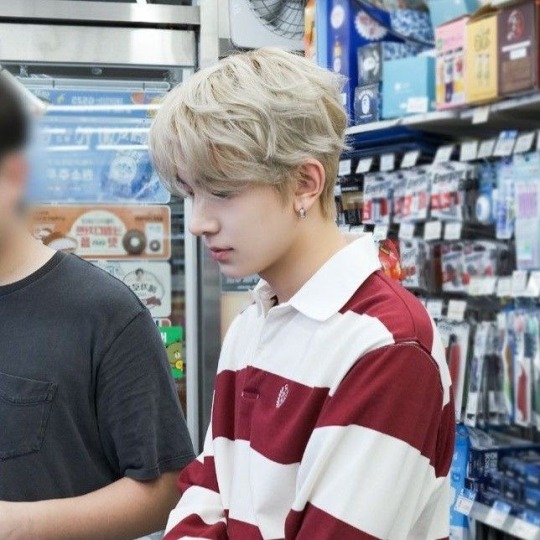
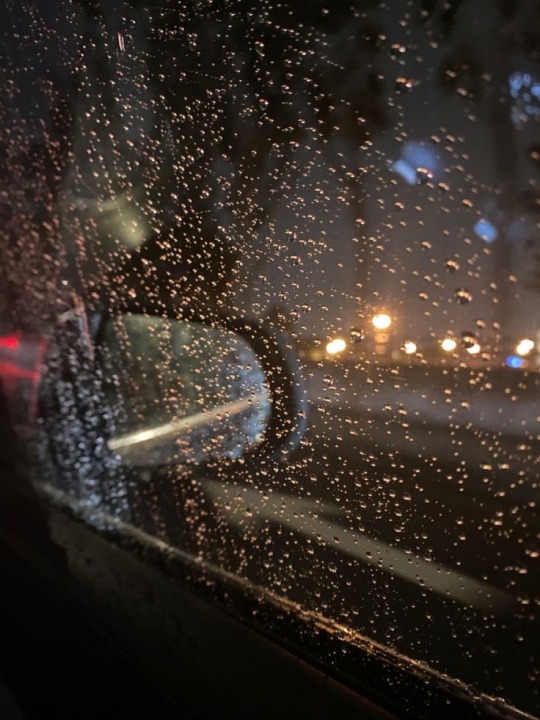
୨୧ pairing — older brother's best friend!lee heeseung x park!fem!reader
୨୧ synopsis — living under the protective eyes of your older brother, park sunghoon, he thinks he knows you the best. but litte does he know that heeseung knows you love your sour patch kids more than you love his usual swedish fish. (inspired by the summer i turned pretty scene where conrad knows belly's taste of candies more than jeremiah)
୨୧ genre — non!idol au, you're 20 and hee is 22, you and hee are dating but sunghoon doesn't know, sort of childhood friends to lovers?
୨୧ warnings — cursing, forbidden (ish) romance, cute fluff where heeseung knows you best, backstreet dating behind sunghoon's back, heeseung and sunghoon having a little quarrel, possesive/sassy-ish hee
୨୧ word count — 562 words, 3148 characters (sort of proofread?)
୨୧ author's note — first blurb and i lowkey wrote this on my phone during english class.. had to get this out of my system cause i absolutely loved this scene in tsitp. plus i felt like i needed to write something since i won't be releasing "it's a crisis"'s full fic anytime soon since i'm busy with exams coming up :(

𝐒𝐔𝐍𝐆𝐇𝐎𝐎𝐍 𝐋𝐈𝐊𝐄𝐃 𝐓𝐎 𝐓𝐇𝐈𝐍𝐊 𝐇𝐄 𝐊𝐍𝐄𝐖 𝐘𝐎𝐔 𝐓𝐇𝐄 𝐌𝐎𝐒𝐓.
the car comes to a stop under the gas station’s bright led light. sunghoon takes off his seatbelt as he grabs his wallet in his pocket, before exiting the car, leaving you and heeseung alone.
you could feel the tension between you and heeseung. the heavy rain outside making it seem louder. he was slumped over in the backseat with his phone in his hand, the bright light illuminating his features.
when did he become so handsome?
sunghoon opens the driver’s side’s door, “we’re two hours away from home, gas is filling up and i’m gonna get some snacks. you want any y/n?”
“i’m down with anything, honestly.” you respond.
as sunghoon is about to close the door, heeseung takes off his seatbelt, whispering a “i’ll come with.” before closing the car door.
the mini market’s door rings a slight ding! as sunghoon pushes the door open. the constant buzzing of the refrigerator and the broken acs filled the room. the two split up searching for bare necessities like snacks and water to keep them company on the way home.
as a couple minutes passed, the two found each other again at the cash register, dropping the things at checkout.
in sunghoon’s hands was a bag of swedish fish, meanwhile in heeseung’s was a bag of sour patch kids.
“don’t waste your money bud, she likes these better.” heeseung snickered, a smirk on his face.
sunghoon lets out a sigh, “they’re practically the same.” he defends himself.
“not to y/n. she thinks swedish fish tastes like candles. she likes sour.”
“why do you even care, hee?” he asks him. “she’s my sister, i know her.”
heeseung licks his lips as he lets out a small laugh, “i don’t.”
“that’s bullshit.” sunghoon scoffs.
“you still want these?” the cashier asks the two, pointing at the swedish fish.
“yes yes, of course.” sunghoon answers.
“i tried to warn him.” heeseung laughs at his best friend.
“why are you acting lik—like this?!” sunghoon asks, a slight bit of anger heard through his voice.
“relax, you big fucking baby. i’m just messing with ya man.” heeseung chuckles, giving his best friend a pat on the back.
with a glare, sunghoon taps his debit card at the scanner, paying for their snacks, picking up the plastic bag and murmuring a small thank you, to the cashier, before they rush out back into their car in the pouring rain.
as the two car doors slam, you take the plastic bag from sunghoon’s hands, diving in.
“what did you get?” you ask the two, ruffling the inside of the bag.
“ooh! sour patch, my favorite!” you glimmer, opening the package as you dive into the sour goodness. but you didn’t miss the bag of swedish fish in sunghoon’s hands.
“oh! i could, um, eat this swedish fish… after?”
sunghoon opened the bag before he responded with a “no, no it’s okay. i got them for me.” as he popped a little fish in his mouth, chewing with disappointment.
“okay.”
sunghoon’s brows furrowed, knowing damn well that his best friend was right.
even from the backseat, he could feel heeseung shooting him a look that was screaming i told you so! before he put the car into ignition.
as sunghoon pressed the gas and started driving into the dark rainy night, his sister chewing on her sour patch kids, he heard heeseung letting out small whisper right in his ear.
“you see? my girl knows her sour patch kids.”

taglist; @ariadores
back to my masterlist?
© 𝐀𝐋𝐋𝐅𝐎𝐑𝐇𝐄𝐄, est. 2024 | do not plagiarize, modify, translate, or repost my works on any platforms.
#allforhee#allforhee-writes#enhypen x reader#enhypen#lee heeseung x reader#enhypen fic#enhypen imagines#heeseung x reader#lee heeseung#lee heeseung imagines#lee heeseung fluff#enhypen fluff#lee heeseung oneshots#lee heeseung au#lee heeseung blurbs#enhypen blurbs#enhypen aus#enhypen au#sunghoon#park sunghoon#park sunghoon x reader#enha#enha x reader#enha fluff#heeseung fluff#enhypen angst#the summer i turned pretty#enhypen blurb#enhypen fanfiction#lee heeseung fanfiction
729 notes
·
View notes
Text
Vaping altogether is unnecessary. Vaping with disposable, single-use vapes is that, and also mindless damage done to the environment when other vape options exist. Sign the petition below to ban single use vapes in the UK!
#vapers#vape#vapefam#disposable vape#vapenation#sign the petition#please sign and share#environment and nature#nature#recycling#climate activism#climate crisis#greenpeace#pollution#polluted water#petition#address#animal rights#plastic#plastic waste#zero waste#make it stop#i love nature#plastic pollution#no plastic#polluted#vapeshop#vapelife#vaping#better future
1 note
·
View note
Text
Recently, I attended a conference where people referred to it as the ‘triple planetary crisis’ (climate change, biodiversity loss and plastic/waste pollution) and honestly I think it’s a game changer, shorter to say that ‘climate and ecological crisis’, leaves out a lot of the words that switch people off (warming, extinction, etc) and yet conveys urgency and a sense of universal responsibility. What do you guys think?
#solarpunk#hopepunk#environmentalism#social justice#community#climate justice#bright future#terminology#triple planetary crisis
628 notes
·
View notes